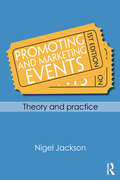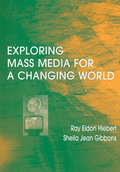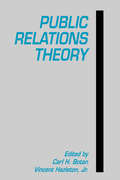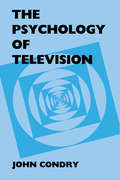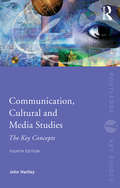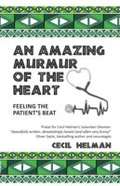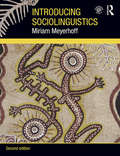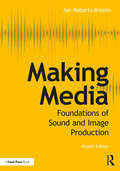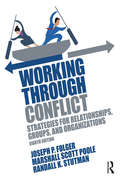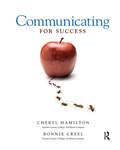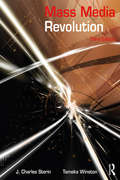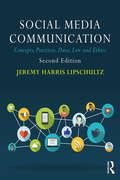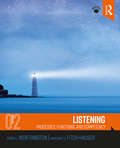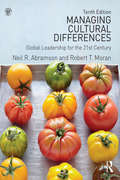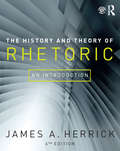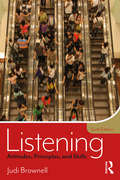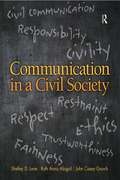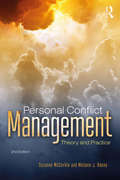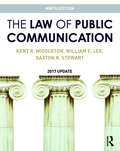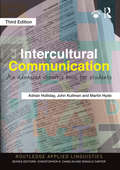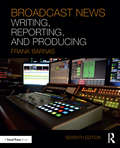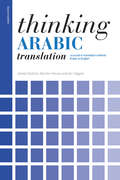- Table View
- List View
Promoting and Marketing Events: Theory and Practice
by Nigel JacksonThis accessible book introduces students to the theories, concepts and skills required to promote an event successfully. To promote an event effectively it is essential to understand marketing, but it is also important to recognise that it is not just consumers who are the audience: other publics who may not necessarily attend can have a fundamental effect on the success of an event as well. Uniquely therefore, this book covers two related themes: marketing and public relations in an events context. This will offer events planners a comprehensive guide on how to promote events to a range of audiences, and on how to use this to manage an event’s long-term reputation. The book focuses on core marketing and PR current theory specifically relevant to the events industry and introduces topics such as marketing strategy, the consumer, marketing PR and how to use the internet to promote events. It integrates a range of international case studies from small-scale events to mega-events to help show how theory can be applied in practice. It further includes inserts of interviews with practitioners in the field, to offer insight into the realities of event communication and to show how to overcome potential pitfalls. Learning outcomes, discussion questions and further reading suggestions are included to aid navigation throughout the book, spur critical thinking and further students’ knowledge. The book is essential reading for all students studying Events Management, and provides valuable reading for students, academics and practitioners interested in marketing and public relations in general.
Exploring Mass Media for A Changing World
by Ray A Hiebert Sheila GibbonsBeautifully written and class tested, Exploring Mass Media for a Changing World provides a comprehensive but modestly priced text around which instructors can develop a customized teaching package. Written for introductory courses, it covers essential information students need in order to understand the media, the mass communication process, and the role of media in society. It summarizes basic, generally agreed-upon principles, theories, significant historical events, and essential facts, but does so in a tightly written, readable style. Taken together, this information can be thought of as a minimum repertoire that all citizens of the "information age" need in order to become literate consumers and users of mass communication. Features include: *Historical Framework--For ease of comprehension, media processes and individual media are placed in historical context to show their technological evolution and the effects of those changes on society. *Organization--The first seven chapters deal with the evolution of communication theories and processes common to all media. The next five deal with specific media in the chronological order in which they became mass media. Chapters 13 and 14 introduce two non-media institutions (advertising and public relations) whose exploration is essential in order to understand how mass media functions in our society. Finally, chapter 15 returns to the theme of technological evolution and its effects on society with an in-depth discussion of the internet. *Flexibility--Because it is concise, affordable, and comprehensive, it can be used either as a stand-alone text in mass media courses or as part of an instructional package in courses where mass communication is one of several major units. *Themes--The following themes are introduced early and carried throughout: (a) the evolution of media technology and its effects on society, (b) the global and culture-bound characteristics of mass media, and (c) the need for media literacy in the 21st century. *Supplements--An accompanying instructor's manual begins with a chapter-length essay on teaching the mass media course then offers the following items for each chapter: topical outline and key vocabulary; key ideas to be emphasized and pitfalls to be avoided; discussion questions; objective and essay test items; and both print and nonprint resources for further study.
Public Relations Theory
by Carl H. BotanBeginning with the basic premise that public relations can best be understood as a specialized type of communication, the contributors to this volume establish public relations as a vital and viable realm for communication research and theory development. Through the application of communication theories, they attempt to explain and predict public relations practices and then use these practices to develop communication theories. Their discussions fall into three distinct categories: metatheory, theory, and examples of applications of theories. An ideal volume for professionals and students in communication, journalism, and related fields.
The Psychology of Television
by John CondryThis volume addresses the content of television -- both programs and advertisements -- and the psychological effects of the content on the audience. The author not only reports new research, but explains its practical applications without jargon. Issues are discussed and described in terms of psychological mechanisms and causal routes of influence. While primarily referring to the American television industry and American governmental regulations, the psychological principles discussed are applicable to television viewers world wide.
Communication, Cultural and Media Studies: The Key Concepts (Routledge Key Guides)
by John HartleyThis fourth edition of Communication, Cultural and Media Studies: The Key Concepts is an indispensible guide to the most important terms in the field. It offers clear explanations of the key concepts, exploring their origins, what they’re used for and why they provoke discussion. The author provides a multi-disciplinary explanation and assessment of the key concepts, from ‘authorship’ to ‘censorship’; ‘creative industries’ to ‘network theory’; ‘complexity’ to ‘visual culture’. The new edition of this classic text includes: Over 200 entries including 50 new entries All entries revised, rewritten and updated Coverage of recent developments in the field Insight into interactive media and the knowledge-based economy A fully updated bibliography with 400 items and suggestions for further reading throughout the text
Communication, Cultural and Media Studies: The Key Concepts (Routledge Key Guides)
by John HartleyThis fourth edition of Communication, Cultural and Media Studies: The Key Concepts is an indispensible guide to the most important terms in the field. It offers clear explanations of the key concepts, exploring their origins, what they’re used for and why they provoke discussion. The author provides a multi-disciplinary explanation and assessment of the key concepts, from ‘authorship’ to ‘censorship’; ‘creative industries’ to ‘network theory’; ‘complexity’ to ‘visual culture’. The new edition of this classic text includes: Over 200 entries including 50 new entries All entries revised, rewritten and updated Coverage of recent developments in the field Insight into interactive media and the knowledge-based economy A fully updated bibliography with 400 items and suggestions for further reading throughout the text
An Amazing Murmur Of The Heart (PDF)
by Cecil HelmanCecil Helman - GP, award-winning anthropologist and acclaimed writer - looks back on a life-time of encounters with patients to ask: 'Where has the patient gone?' And answers that patients 'are still here, waiting for their doctors to notice them again, to shift their attention away from all their magic machines and high tech tests, and to listen to their stories again. And hidden away in those stories, to hear the faint, almost inaudible, murmuring of their hearts.' An Amazing Murmur of the Heart mingles those patients' stories with Cecil's understanding that medicine is an art, though rooted in science, and that by listening to what the sick are saying - not necessarily just in words - healthcare professionals can do more than simply cure symptoms - they can heal.
Introducing Sociolinguistics (PDF)
by Miriam MeyerhoffThis second edition of Miriam Meyerhoff’s highly successful textbook is supported by the Routledge Sociolinguistics Reader and online resources common to both books. It provides a solid, up-to-date appreciation of the interdisciplinary nature of the field covering foundation issues, recent advances and current debates. It presents familiar or classic data in new ways, and supplements the familiar with fresh examples from a wide range of languages and social settings. It clearly explains the patterns and systems that underlie language variation in use, as well as the ways in which alternations between different language varieties index personal style, social power and national identity. New features of the second edition: a wider range of approaches to politeness theory incorporating an international range of research expanded sections on multi-lingualism and code-switching, social class, dialect contact and tracking change over time linkage to the new Routledge Sociolinguistics Reader which can be used alongside this textbook, allowing students to supplement and build on material covered in the textbook. a shared website serving both Reader and Textbook which includes web- and video-links, interactive exercises and an expanded online glossary at: www.routledge.com/textbooks/meyerhoff a refreshed text design to assist navigation through textbook and reader. Each chapter includes exercises that enable readers to engage critically with the text, break-out boxes making connections between sociolinguistics and linguistic or social theory, and brief, lively add-ons guaranteed to make the book a memorable and enjoyable read. With a full glossary of terms and suggestions for further reading, this text gives students all the tools they need for an excellent command of sociolinguistics.
Making Media: Foundations of Sound and Image Production
by Jan Roberts-BreslinMaking Media: Foundations of Sound and Image Production takes the media production process and deconstructs it into its most basic components. Students will learn the basic concepts of media production – frame, sound, light, time, motion, and sequencing – and be able to apply them to any medium they choose, from film and television to fine art and online applications. They will also become well-grounded in the digital work environment and the tools required to produce media in today’s digital environment. This new fourth edition is completely updated and includes a new chapter on the production process and production safety; information on current trends in production, exhibition, and distribution; and much more. New topics include virtual and augmented reality, the use of drones and new practices interactive media. The text is also fully illustrated and includes sidebar discussions of pertinent issues throughout. The companion website has been completely revamped with interactive exercises for each chapter, allowing students to explore the process of media production.
Working Through Conflict: Strategies for Relationships, Groups, and Organizations
by Joseph Folger Marshall Scott Poole Randall K. StutmanNow in its eighth edition, Working Through Conflict provides an introduction to conflict and conflict management that is firmly grounded in current theory, research, and practice, covering a range of conflict settings (interpersonal, group, and organizational). The text includes an abundance of real life case studies that encompass a spectrum of theoretical perspectives. Its emphasis on application makes it highly accessible to students, while expanding their comprehension of conflict theory and practical skills. This new edition features a wealth of up-to-date research and case examples, suggested readings and video resources, and integrated questions for review and discussion.
Communicating for Success
by Cheryl M. HamiltonThis text focuses student-learning on the key communication competencies recommended by the National Communication Association. With applied examples and a vibrant and engaging design, this text covers all the expected topics in an introductory course (foundations of communication, interpersonal communication, small group communication, and public speaking - plus a special appendix on interviewing). Scenarios begin each chapter with a problem to which students can relate and then solve as they learn about the concepts discussed in each chapter. A concentrated focus on careers in communication, highlighted in a two-page spread near the end of each chapter, brings home the relevance of communication outside the classroom and helps students learn more about how studying communication can help them throughout their lives. Additional emphasis on topics such as ethics, culture, gender, and technology is found throughout the text.
Communicating for Success
by Cheryl M. HamiltonThis text focuses student-learning on the key communication competencies recommended by the National Communication Association. With applied examples and a vibrant and engaging design, this text covers all the expected topics in an introductory course (foundations of communication, interpersonal communication, small group communication, and public speaking - plus a special appendix on interviewing). Scenarios begin each chapter with a problem to which students can relate and then solve as they learn about the concepts discussed in each chapter. A concentrated focus on careers in communication, highlighted in a two-page spread near the end of each chapter, brings home the relevance of communication outside the classroom and helps students learn more about how studying communication can help them throughout their lives. Additional emphasis on topics such as ethics, culture, gender, and technology is found throughout the text.
Mass Media Revolution
by J. Charles Sterin Tameka WinstonNow in its Third Edition, Mass Media Revolution remains a dynamic guide to the world of mass media, enhancing its readers’ development as critical consumers. The text employs a storytelling narrative style and integrated, chapter-specific digital material, providing a seamless learning experience. It features a wealth of expanded content—with particular attention to diversity in the media industry, reality TV, ethics and social media, and the evolution of online journalism. Chapter content, both print and online, is aligned to the ACEJMC national academic standards. Along with student video resources, this text includes an accompanying instructor resource manual and Power Point slides. All supplementary materials can be found at massmediarev.com.
Social Media Communication: Concepts, Practices, Data, Law and Ethics
by Jeremy Harris LipschultzIn the second edition of Social Media Communication: Concepts, Practices, Data, Law and Ethics, Jeremy Harris Lipschultz presents a wide-scale, interdisciplinary analysis and guide to social media. Examining platforms such as Facebook, Instagram, Snapchat, LinkedIn, YouTube and Pinterest, this book explores and analyzes journalism, broadcasting, public relations, advertising and marketing. Lipschultz focuses on key concepts, best practices, data analyses, law and ethics—all promoting the critical thinking professionals and students need to use new networking tools effectively and to navigate social and mobile media spaces. Featuring historical markers and contemporary case studies, essays from some of the industry’s leading social media innovators and a comprehensive glossary, this practical, multipurpose textbook gives readers the resources they’ll need to both evaluate and utilize current and future forms of social media. For more information about the book, supplementary updates and teaching materials, follow the Social Media Communication Facebook page, @JeremyHL on Twitter and the UNO Social Media Lab on SlideShare. Facebook: www.facebook.com/SocialMediaCommunication Twitter: @JeremyHL #UNOSML #SMC2018 #SMProfs SlideShare: www.slideshare.net/jeremylipschultz
Listening: Processes, Functions, and Competency
by Debra L. Worthington Margaret E. Fitch-HauserListening: Processes, Functions, and Competency, Second Edition explores the role of listening as an essential element in human communication. The book addresses listening as a cognitive process, as a social function, and as a critical professional competency. Blending theory with practical application, Listening builds knowledge, insight, and skill to help the reader achieve the desired outcome of effective listening. This second edition introduces listening as a goal-directed activity and has been expanded to include a new chapter addressing listening in mediated contexts. Theory and research throughout the text have been updated, and the final chapter covers new research methodologies and contexts, including fMRI, aural architecture, and music.
Managing Cultural Differences: Global Leadership for the 21st Century
by Robert T. Moran Neil Remington AbramsonIn today’s global business environment, it is vital that individuals and organizations have sophisticated global leadership skills. Communication and understanding of different cultures is paramount to business success. This new edition of the bestselling textbook, Managing Cultural Differences, guides students and practitioners to an understanding of how to do business internationally, providing practical advice on how competitive advantage can be gained through effective cross-cultural management. Crises in the Middle East, the weakening of some emerging markets, and the value of diversity and inclusion are just a few examples of contemporary issues discussed in this text, which also introduces a completely new chapter on global business ethics. With a wealth of new examples, case studies, and online materials, this textbook is required course reading for undergraduates, postgraduates, and MBA students alike, as well as being a vital tool for anybody selling, purchasing, traveling, or working internationally.
The History and Theory of Rhetoric: An Introduction
by James A. HerrickBy tracing the traditional progression of rhetoric from the Greek Sophists to contemporary theorists, The History and Theory of Rhetoric illustrates how persuasive public discourse performs essential social functions and shapes our daily worlds. Students gain a conceptual framework for evaluating and practicing persuasive writing and speaking in a wide range of settings and in both written and visual media. This new 6th edition includes greater attention to non-Western studies, as well as contemporary developments such as the rhetoric of science, feminist rhetoric, the rhetoric of display, and comparative rhetoric. Known for its clear writing style and contemporary examples throughout, The History and Theory of Rhetoric emphasizes the relevance of rhetoric to today’s students.
Listening: Attitudes, Principles, and Skills
by Judi BrownellListening, Sixth Edition takes an experiential approach to listening instruction, providing extensive applied examples and cases within the context of the HURIER listening model. The text encourages students to view listening as a process involving six interrelated components, which are developed along the parallel dimensions of theory and skill building. This new edition offers a companion website as well as additional and updated cases, in-text exercises, and questions for discussion. Throughout the text, new content has been added to address students’ world of evolving technology and expanding social boundaries. Included in the new edition: The complexities of listening to social media and the unique challenges presented by mediated communication New and expanded topics in Listening Challenges, including listening as it relates to career communication and business contexts Suggested techniques for encouraging others to listen The new requirements of listening across cultural and generational boundaries, emphasized throughout Opening cases that present timely issues related to the listeners’ social responsibilities A personal journal assignment in each chapter
Communication in a Civil Society
by John Gooch Ruth Anne Abigail Shelley D. LaneFirst Published in 2016. Routledge is an imprint of Taylor & Francis, an Informa company.
Personal Conflict Management: Theory and Practice
by Suzanne Mccorkle Melanie ReesePersonal Conflict Management, 2nd edition details the common causes of conflict, showcases the theories that explain why conflict happens, presents strategies for managing conflict, and invites consideration of the risks of leaving conflict unsettled. This book also explores how gender, race, culture, generation, power, emotional intelligence, and trust affect how individuals perceive conflict and choose conflict tactics. Detailed attention is given to the role of listening and both competitive and cooperative negotiation tactics. Separate chapters explain how to deal with bullies and conflict via social media. The volume caps off its investigation of interpersonal conflict with chapters that: provide tools to analyze one’s conflicts and better choose strategic responses; examine the role of anger and apology during conflict; explore mediation technique; and evaluate how conflict occurs in different situations such as family, intimacy, work, and social media.
The Law of Public Communication: 2017 Update
by Kent R. Middleton William E. Lee Daxton StewartThe Law of Public Communication provides an overview of media law that includes the most current legal developments today. It explains the laws affecting the daily work of writers, broadcasters, advertisers, cable operators, Internet service providers, public relations practitioners, photographers, bloggers, and other public communicators. Authors Kent R. Middleton, William E. Lee, and Daxton R. Stewart take students through the basic legal principles and methods of analysis that allow students to study and keep abreast of the rapidly changing field of public communication. By providing statutes and cases in a cohesive manner that is understandable, even to students studying law for the first time, the authors ensure that students will acquire a firm grasp of the legal issues affecting the media. This 2017 Update brings the Ninth Edition up to date with the most recent cases and examples affecting media professionals and public communicators.
The Law of Public Communication: 2017 Update
by Kent R. Middleton William E. Lee Daxton StewartThe Law of Public Communication provides an overview of media law that includes the most current legal developments today. It explains the laws affecting the daily work of writers, broadcasters, advertisers, cable operators, Internet service providers, public relations practitioners, photographers, bloggers, and other public communicators. Authors Kent R. Middleton, William E. Lee, and Daxton R. Stewart take students through the basic legal principles and methods of analysis that allow students to study and keep abreast of the rapidly changing field of public communication. By providing statutes and cases in a cohesive manner that is understandable, even to students studying law for the first time, the authors ensure that students will acquire a firm grasp of the legal issues affecting the media. This 2017 Update brings the Ninth Edition up to date with the most recent cases and examples affecting media professionals and public communicators.
Intercultural Communication: An Advanced Resource Book for Students (Routledge Applied Linguistics)
by Adrian Holliday John Kullman Martin HydeRoutledge Applied Linguistics is a series of comprehensive textbooks, providing students and researchers with the support they need for advanced study in the core areas of English language and Applied Linguistics. Each book in the series guides readers through three main sections, enabling them to explore and develop major themes within the discipline. • Section A, Introduction, establishes the key terms and concepts and extends readers’ techniques of analysis through practical application. • Section B, Extension, brings together influential articles, sets them in context, and discusses their contribution to the field. • Section C, Exploration, builds on knowledge gained in the first two sections, setting thoughtful tasks around further illustrative material. This enables readers to engage more actively with the subject matter and encourages them to develop their own research responses. Throughout the book, topics are revisited, extended, interwoven and deconstructed, with the reader’s understanding strengthened by tasks and follow-up questions. This highly-successful text introduces and explores the dynamic area of intercultural communication, and the updated third edition features: • new readings by Prue Holmes, Fred Dervin, Lei Guo and Summer Harlow, Miriam Sobré-Denton and Nilaniana Bardham, which reflect the most recentdevelopments in the field • refreshed and expanded examples and exercises including new material on the world of business, radicalisation and cultural fundamentalism • extended discussion of topics which include cutting-edge material on cosmopolitanism, immigrants’ intercultural communication and cultural travel • revised further reading. Written by experienced teachers and researchers in the field, Intercultural Communication, Third edition provides an essential textbook for advanced students studying this topic.
Broadcast News Writing, Reporting, and Producing
by Frank BarnasBroadcast News Writing, Reporting, and Producing, 7th Edition is the leading book covering all aspects of writing and reporting the news. It identifies the key concepts and terms readers need to know in the news gathering and dissemination process, and provides practical, real-world advice for operating in the modern day newsroom. New to the seventh Edition are profiles of working journalists who give readers a glimpse into the working life of modern reporters, producers, and directors. This new edition also covers important aspects of the use of social media, drone journalism, and digital technology. A new chapter on portfolio development will assist readers in developing the skills to advance in their careers. The text has also been updated to reflect new industry standards in modes of information gathering and delivery, writing style, and technology. Additional features include: Key words at the start of every chapter, identifying important terms and definitions; End of chapter summaries, which allows readers to review the chapter’s main points; "Text Your Knowledge", which helps readers quiz themselves on important concepts; Chapter-by-chapter exercises, which readers can apply to a chapter’s themes; A companion website featuring video tutorials of necessary skills for journalists, including how to arrange lighting structures, how to hold a microphone, and how to properly conduct an interview.
Thinking Arabic Translation: A Course in Translation Method: Arabic to English (Thinking Translation)
by James Dickins Sándor Hervey Ian HigginsThinking Arabic Translation is an indispensable book for linguists who want to develop their Arabic-to-English translation skills. Clear explanations, discussions, examples and exercises enable students to acquire the skills necessary for tackling a broad range of translation problems. The book has a practical orientation, addressing key issues for translators, such as cultural differences, genre, and revision and editing. It is a book on translation method, drawing on a range of notions from linguistics and translation theory to encourage thoughtful consideration of possible solutions to practical problems. This new edition includes: • new material in almost all chapters • a new chapter on parallelism • two new chapters on technical translation: botanical and Islamic finance texts • new and up-to-date examples from all types of translation, covering broad issues that have emerged in the Arab world in recent years • texts drawn from a wide variety of writing types, including newspapers, prose fiction, poetry, tourist material, scientific texts, financial texts, recipes, academic writing, constitutions and political speeches • at least three full-length practical translation exercises in each chapter to complement the discussions and consolidate learning. In addition to the updated Tutor’s Handbook, a Supplement, containing textual material and practical exercises aimed at further developing the translation issues discussed in the main text, and a Tutor’s Handbook to the Supplement, are available at www.routledge.com/cw/dickins. Thinking Arabic Translation is key reading for advanced students wishing to perfect their language skills or considering a career in translation.
